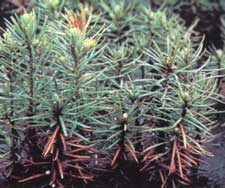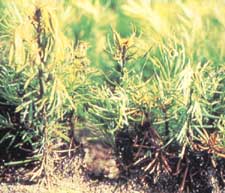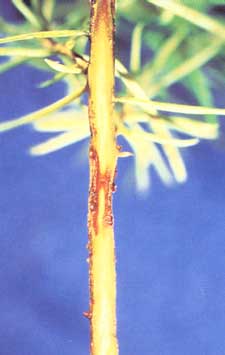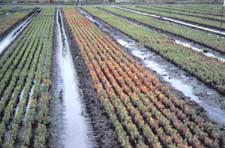Lower Stem CankerPhilip B. Hamm - Senior Research Assistant, Department of Botany and Plant Pathology, Oregon State University, Corvallis, OR, and Cordell C.E., Anderson R.L., Hoffard W.H., Landis T.D., Smith R.S. Jr., Toko H.V., 1989. Forest Nursery Pests. USDA Forest Service, Agriculture Handbook No. 680, 184 pp. Hosts Lower stem canker, caused by the fungi Fusarium roseum and Phoma eupyrena , occurs primarily on Douglas-fir seedlings, though some damage occurs on noble fir. In addition, these fungi are found commonly on a broad range of conifer seedlings without causing disease. Distribution Damage due to lower stem canker occurs in bareroot nurseries in western Oregon and Washington, but the causal fungi are widely distributed. Damage Significant mortality may occur in localized areas. Diagnosis Symptoms first appear on seedlings in late winter or early spring, when temperatures begin to rise. Look for stems encased in soil with lower needles turning brown (fig. 12-1). With time, the tops of infected seedlings turn yellow and later, red brown. Wilting is dramatic if girdling occurs when new growth is present (fig. 12-2).
Generally, damage occurs in areas associated with poor drainage and spreads within beds more rapidly than between beds (fig. 12-4). Damage can be particularly heavy in areas where tractor use during the winter has resulted in the formation of large, deep puddIes of water between beds. Lower stem canker causes foliar symptoms similar to Phytophthora root rot (see chapter 16) but can usually be differentiated from that disease by absence of the root decay associated with Phytophthora and by the presence of a distinct girdling canker on the lower stem. Lower stem canker can readily be confirmed by isolating both fungi from infected stem material on potato dextrose agar. Biology Lower stem canker is a complex disease caused by two organisms, acting singly or together. Fusarium roseum is most commonly associated with the disease; Phoma eupyrena may or may not be present. Both organisms form chlamydospores, which survive in the soil. Chlamydospores or conidia transported via contaminated equipment, blowing soil, or possibly even on seeds serve as inoculum. Infection occurs beneath soil collars built up by rain splash around the lower portion of the main stem. Spores germinate and infect needles, buds, or stem tissue lying beneath the soil collar. Once they invade the stem, these fungi readily form a girdling canker. Neither fungus has been found sporulating on infected tissue. However, large numbers of propagules of both fungi have been found in soil making up soil collars. Control Cultural - Reduce the buildup of soil collars on seedlings by mulching or by allowing naturally occurring moss to form on seedbeds. Chemical - Several fungicides have been tested for control of this disease, but none have significantly reduced mortality. This may be due to the inability of the materials to penetrate the soil collars around the seedling stems. Selected References Cooley, S J; Kanaskie, A. 1986 Evaluation of seven fungicides to control canker diseases in bare-root Douglas-fir in Pacific Northwest nurseries. For. Pest Manage. Rep. R6-86-14. Portland. OR: LAS. Department of Agriculture, Forest Service, Pacific Northwest Region. 23 p. Hamm, P.B.: Hansen, EM.; Kanaskie. AM. 1985. Symptomology of the "top blight" diseases of Douglas-fir bare-root seedlings in the Pacific Northwest. [Abstract.] Phytopathology. 75: 1367. Hansen. EM.; Hamm. PB. [In press.] Canker diseases of Douglas-fir seedlings in Oregon and Washington bare root nurseries. Canadian Journal of Forest Research. Morgan. P. 1983. Fusarium stem rot of Douglas-fir seedlings. Plant Disease. 67: 441 -442. |
Forest Pests: Insects, Diseases & Other Damage Agents |

|
|





